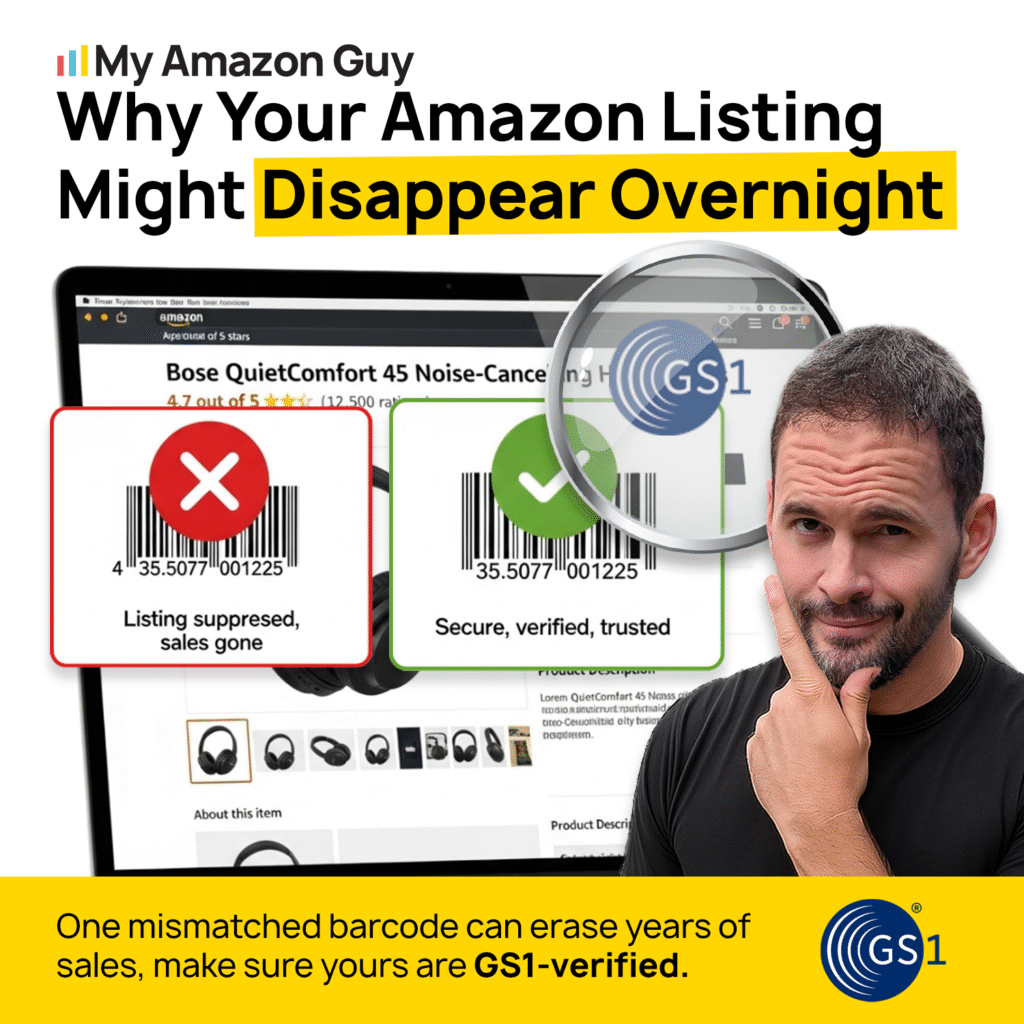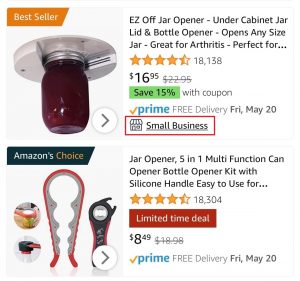
Last Updated: October 10, 2025
Having GS1 barcode issues can trigger Amazon errors that block listings, suppress products, or even lead to account warnings. Why risk all that when you can prevent these problems with the right barcode setup from the start?
Every seller needs a GS1-verified barcode when creating new product listings on Amazon, but many still look for cheaper workarounds. Some buy recycled or non-GS1 codes thinking they can save money, but that shortcut often backfires, leading to listing rejections or compliance headaches.
When Amazon flags a GS1 mismatch, sellers can lose valuable selling time, face listing removals, or get hit with “invalid GTIN” errors that stop sales cold. These barcode problems are more common than you’d think, especially among private-label and resold brands.
In this guide, our Amazon agency explains how GS1 barcode issues can trigger listing errors, suppressed products, and lost sales. You’ll also learn practical strategies to prevent these problems, including buying certified codes, maintaining brand consistency, and cross-checking identifiers to keep your Amazon listings active and error-free.
Table of Contents
Resolve GS1 Barcode Issues Fast
Stop losing sales to suppressed listings or rejected submissions. Our team can help you verify and fix GS1 barcodes quickly so your products stay live.
What Are GS1 Barcodes?
With over 600 million products listed on Amazon, it would be nearly impossible for the platform to track every single item accurately without a standardized system. GS1 barcodes make this process seamless by assigning each product a unique identifier that Amazon can recognize instantly.
For sellers, GS1 barcodes serve as proof that their products are legitimate and properly registered under their brand name. Amazon cross-checks these codes with the GS1 database to ensure the brand information matches, helping prevent hijacked listings, listing rejections, and potential compliance issues.
Why Amazon Sellers Are Running Into GS1 Barcode Issues
Having a valid GS1 barcode is critical for selling on Amazon, but many sellers encounter GS1 barcode issues for various reasons that result in listing rejections, suppressed products, or other Amazon errors. Understanding why these problems happen can help sellers avoid costly delays and maintain active listings.
Here are the most common reasons sellers run into GS1 barcode issues:
- Buying barcodes from third-party websites instead of GS1 can lead to rejection because Amazon verifies ownership against its database.
- Using the wrong identifier when creating a listing triggers errors.
- Conflicts between the GS1-registered brand name and the Amazon listing brand can cause suppressed listings.
- Using a barcode that belongs to another company or individual is common, especially with private-label products.
- Entering a barcode for a product that already exists with the same title or description can create errors.
- Barcodes that are printed incorrectly, too small, too large, or on reflective materials may not scan properly.
- If GS1 or Brand Registry records are not up to date, or if Amazon’s system hasn’t synced after a purchase, errors can occur.
Simplify Amazon Compliance
Managing GS1 barcodes doesn’t have to be complicated. Our full-service Amazon agency handles verification, updates, and cross-checks for you.
Common GS1-Related Problems Amazon Sellers Face
Amazon seller problems often stem from GS1-related issues, which can create a chain reaction of listing errors, suppressed products, and lost sales. Understanding these common challenges helps sellers recognize potential pitfalls before they impact their accounts.
1. Invalid or Duplicate GS1 Barcodes
Many sellers encounter errors because their GS1 barcodes have already been assigned to other products. Amazon flags these as duplicates, preventing new listings from going live and creating confusion in the catalog.
Duplicate barcodes are especially common when codes are purchased from third-party resellers or recycled from old listings. The system treats them as conflicts, which can lead to listing suppressions or verification requests.
2. Brand Name Mismatch
A mismatch between the brand name registered with GS1 and the brand name on Amazon can trigger listing errors. Amazon requires exact matches, and any discrepancy can cause the barcode to be rejected.
This often happens when brands are acquired or private-label products are created without proper coordination. The result is suppressed listings and blocked product launches until the issue is flagged or corrected.
3. Expired or Unrenewed GS1 Licenses
GS1 barcodes now have annual renewal requirements, and expired licenses lead to invalid product identifiers. Amazon can reject listings tied to expired codes, even if the products were previously active.
Sellers who forget to renew or maintain their GS1 account may see multiple listings become inactive simultaneously. This creates unexpected interruptions in sales and listing visibility.
4. Incorrect Product ID Type
Selecting the wrong type of GS1 barcode can result in immediate listing errors. Amazon validates the ID type during product creation and will block submissions with mismatches.
Even experienced sellers sometimes encounter these issues when managing large inventories or migrating products between accounts. Incorrect identifiers prevent listings from going live, which delays sales and inventory turnover.
5. Listing Suppressions or Removals
Invalid GS1 barcodes can lead to entire listings being suppressed or removed from Amazon. This directly impacts product visibility, sales performance, and overall account health.
Suppressed listings remain invisible to customers until Amazon verifies the barcode or flags the issue. The longer the listings remain inactive, the greater the loss in revenue and marketplace presence.
How to Avoid GS1 Barcode Issues That Result in Amazon Errors
The best way to prevent problems caused by GS1 barcode issues is to avoid them before they happen. Following best practices ensures smoother listings, fewer Amazon listing issues, and uninterrupted sales.
1. Always Buy GS1-Certified Codes
Purchasing barcodes directly from GS1 guarantees that your codes are valid and recognized by Amazon. Codes from third-party sellers or retired sources may already be registered or flagged, which can lead to listing rejections.
Using official GS1 codes also protects your brand from duplication issues and prevents Amazon from questioning product authenticity. Even though some sellers try workarounds, non-certified codes are a common cause of suppressed listings and account complications.
2. Maintain Consistency with Your Brand’s GS1 History
If your brand has previously registered codes with GS1, all new products must continue using GS1-certified barcodes. Inconsistent use can trigger Amazon errors, especially for private-label or acquired brands.
Brand history mismatches often lead to verification requests or blocked listings. Sellers who ignore this risk face delays and additional documentation requirements from Amazon.
3. Keep GS1 Certificates Ready
Amazon may request proof that your barcodes are legitimate, especially if errors are flagged. Having the GS1 certificate on hand allows you to respond quickly and avoid prolonged listing suppression.
This documentation is essential for verifying ownership of your code. Without it, even valid codes can be rejected if Amazon cannot confirm authenticity.
4. Monitor Expiration and Renewal Requirements
GS1 barcodes now require annual renewal, and expired codes can become invalid on Amazon. Failing to renew on time can result in blocked listings or “invalid GTIN” errors.
Sellers should track their GS1 account status and plan renewals in advance. Staying current prevents unexpected disruptions to active product listings.
5. Cross-Check Barcode Type Before Listing
Selecting the correct type of GS1 barcode is crucial when creating new listings. Using the wrong type triggers Amazon listing issues and can prevent the listing from going live.
Even minor mistakes in barcode type selection can create compliance issues. Double-checking each product identifier ensures smooth processing and avoids unnecessary delays.
We are an official GS1 Channel Partner, providing Amazon sellers with direct access to GS1 identifiers, including GTINs (Global Trade Item Numbers).
Frequently Asked Questions
What happens if my GS1 barcode is invalid on Amazon?
Invalid barcodes can result in listing suppression, rejected product submissions, or account verification requests. You’ll need to provide proof of ownership or replace the code with a valid GS1 barcode.
Do GS1 barcodes expire?
Yes. GS1 barcodes require annual renewal to remain valid. Expired codes can trigger Amazon errors and prevent listings from going live.
Where can I get GS1-certified barcodes?
You can purchase GS1-certified barcodes directly from the official GS1 website for your country. Avoid third-party sellers, as Amazon may reject codes not issued by GS1.
Stop GS1 Barcode Errors from Holding Back Your Amazon Sales
When sellers experience Amazon errors due to GS1 barcode issues, it can feel like the end of the world since it could result in suppressed listings, lost sales, or account complications. We understand how frustrating this can be for anyone trying to grow their brand on Amazon, so using this guide helps you identify and prevent these problems before they happen.
GS1 barcode issues don’t have to stall your business or create ongoing headaches. By following best practices like buying certified codes, maintaining brand consistency, and cross-checking identifiers, sellers can keep listings active and avoid costly delays.
Don’t know what to do when experiencing a GS1 barcode or Amazon listing error? Reach out to our full-service Amazon agency, and let us help you resolve these issues stress-free so you can focus on growing your sales and scaling your brand.
Keep Your Amazon Listings Active
Avoid the headaches of invalid barcodes and blocked listings. Let us ensure your GS1 codes are compliant and your inventory remains visible to customers.







